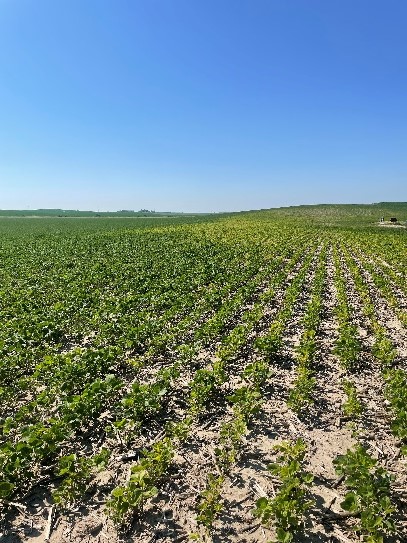Iron Deficiency Chlorosis in Soybeans
Each year, it’s not uncommon to see yellow-colored spots in soybean fields scattered throughout the Midwest. Often, the yellow appearance of soybeans is caused by iron deficiency chlorosis, or IDC for short. Let’s take a look at what causes IDC and how growers can help with this issue.
What causes iron deficiency chlorosis in soybeans?
IDC in soybeans is typically caused by soils with a high pH, typically above 7.4. This can be a found on hillsides that have lost their topsoil over time due to erosion, land that’s been leveled for gravity irrigation, potholes, or in western Nebraska, land that lays in a old river valley. High pH soils often contain an excess of lime or calcium carbonate.
Wet soils have limited air exchange with air in the atmosphere. This causes a buildup of carbon dioxide, which is produced by plants and soil microbes. According to the University of Minnesota, “The amount of bicarbonate in the soil is proportional to the amount of carbon dioxide, and as carbon dioxide increases so does bicarbonate. This increase will rapidly neutralize the acidity around the soybean root.”
Nitrates in the soil can also have an effect on IDC in a soybean field. A soybean plant will consume soil nitrogen before it begins to nodulate and provide its own nitrogen. When a plant uptakes soil nitrogen, it must exchange the nitrogen ion with a bicarbonate ion. The nitrogen that’s absorbed into the plant is converted into the ammonium form of nitrogen, which further increases pH in the plant’s leaves.
Most forms of plant stress can further compound this issue. Herbicide injury, soybean cyst nematode pressure, and disease pressure can all increase the severity of IDC.
How to manage soybean IDC
Choose a soybean variety that’s tolerant to IDC. It is important to note that no soybean is immune to showing IDC symptoms, but some varieties are much more tolerant than others. Hoegemeyer offers several varieties with great pH ratings, including products like 1824 E, 2123 E, 2202 NX, 2604 E, and 3953 E.
Use a chelated iron product. An ortho-ortho blend of an iron product will greatly reduce the yellow color in soybean fields and has been shown by university trials to positive return on investment when applied in furrow. A foliar application of chelated iron will “green up” the canopy for a while, but university trials suggest that this is an inconsistent practice.
Lastly, increasing seeding rates in areas with IDC issues has been shown to increase return. Farmers should try to avoid having a low population in these areas, as that can increase stress on each plant. However, in University of Minnesota trials, increasing seeding rate did not benefit the producer as much as using a chelated iron product.


Agronomist Contact Info:
Phil Swantek, Western Region Product Agronomist
p.swantek@hoegemeyer.com
Sources
- https://extension.umn.edu/crop-specific-needs/managing-iron-deficiency-chlorosis-soybean#consider-seeding-rates-1074264
